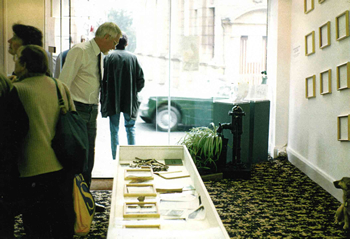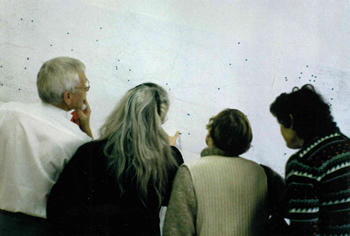“THE SPRING WATER ARTS PROJECT” 1996 - 2000

While Rose Garrard was Artist in Residence in Calgary and Vancouver Art Galleries, Canada in the early 1990’s, global ecological issues came to the fore when water was described to her as “the new gold” by residents. Conversations with the public revealed that the ownership, damming and control of water sources were a primary point of conflict between native and settler residents. On a visit to a village of the coastal Salish peoples in 1992, an elder suggested that Rose took an active responsibility for these same issues when she returned to her “home” in England.
“But now with the first signs of global warming beginning to show, the foremost of the villager’s concerns was over the water rights within the reservation, which they had sold off for a large sum several years before. At the time this had seemed a good commercial deal, but the elders were starting to wonder if they had been wise. Therese said “Pure water will become the most precious and rare resource in the 21st century.”
The villages of the Malverns have grown up along the flanks of the Malvern Hills, which form a boundary between Herefordshire and Worcestershire. This nine mile long range of ancient granite peaks has a necklace of springs around it, most arising where the insoluble granite meets the lower sedimentary layers of rock. Recently all Britain`s water had been privatised without much opposition.

I described how Malvern`s water sources were taken for granted throughout the 20th century, neglected, damaged, capped and piped underground as waste-water, yet if global warming caused catastrophic flooding as some predicted, how these high springs could become lifesavers. Therese listened, looked at me long and hard and just gently said, “Go home.” With this little phrase I was being reminded that this was where I had a real responsibility to offer help, in Malvern. Malvern had been my childhood home, but I had relished leaving it for the excitement of city life in London and had never contemplated going back except for visits to family. But three years later I had bought a house here…”
‘Malvern Hill of Fountains’ by Rose Garrard, published 2006
In response to local newspaper appeals for ideas to help regenerate Great Malvern, by June 1996 sculptor Rose Garrard, still living in London, had developed and independently proposed the “Spring Water Arts Project” to the Malvern Hills District Council Planning Office. This was for the creation of a “Malvern Water Trail” of new sculptures by local and nationally known sculptors on ‘lost’ spring sites throughout the town centre. Although the Malverns were famous for their numerous natural springs, at that time only six accessible public spouts still supplied drinkable spring water and no sources were now visible in Great Malvern itself. Pure spring water could only be drunk at Hay Slad, St Ann’s Well, Holy Well, Earl Beauchamp’s Spout, Evendine and Westminster Bank Springs.

In August 1996 the Council appointed a Spa Water Strategy Working Group of local people to address the role that water could play in the revitalisation of the town centre as part of their Regeneration Strategy. At the first meeting of the Spa Working Group on 20th September 1996, Rose was invited to present her ideas for the “Malvern Water Trail” and the Strategy Group then identified two main objectives;-
-
The establishment of sites for new town centre water features, and
-
The restoration and conservation of the springs of the Malvern Hills.
In line with their main objective to regenerate Great Malvern, the District Council decided that it did not have sufficient resources to pursue both routes and so proceeded only with the creation of new town centre water features. In October 1997 the Council implemented the “Spring Water Arts Project”, commissioning Rose to undertake research for the water trail in a two-month long Artist’s Residency in a vacant town centre shop. As with her previous ‘Conversation’ installations in four major galleries in Britain and Canada, the public came daily to talk to her, but now it was to tell to her about Malvern’s history and springs. Having previously focussed on this listening activity as the basis for galley art, in Malvern Rose sought to apply this live-art process to the creation of Public Art in the outside world. Now the local residents brought Rose their stories, texts and memorabilia connected with the springs to put into the long display cases and they also recorded 245 remembered water sites around the hills on two huge wall maps, including streams, ponds, and over 100 spouts, wells and springs, many of which were badly neglected or had been piped underground and ‘lost’.

In her subsequent report to the District Council, Rose identified 14 possible town centre spring water sites and suggested 33 historical themes for commissions to other artists. Rose was then commissioned to create a small town centre spring water drinking spout, which was unveiled on 4th September 1998 and following suggestions from the public the name ‘Malvhina’ was chosen for this sculpture. A further commission on the same site followed in April 1999, now for a major municipal spring water feature by Rose. Completed on budget and in time to celebrate the millennium, ‘The Enigma Fountain’ was unveiled by Prince Andrew on 26th May 2000. Both sculptures can be seen on the central town site of Belle Vue Island. Different artists were to have been commissioned through competitive interview to undertake each subsequent site. But sadly, with changes in the District Council following local elections, no new Arts Officer was appointed, disqualifying “The “Spring Water Arts Project” from future Arts Council grant aid and so no further artists were commissioned and the trail project had to be abandoned.